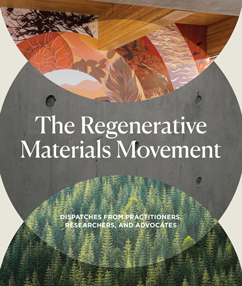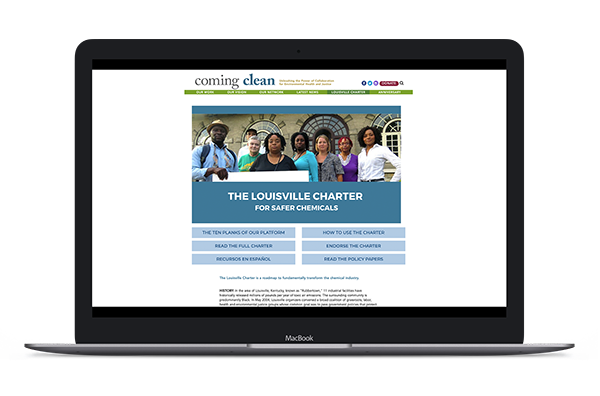 READ HABITABLE’S NEW REPORT
READ HABITABLE’S NEW REPORT
This comprehensive guide, designed for architects, engineers, and contractors, provides expert insights, academic research, and practical advice on various aspects of piping systems, including material properties, safety considerations, health risks, environmental impacts, and emerging trends.

In this study several commercial paints were analyzed for volatile and nonvolatile per- and polyfluoroalkyl substances (PFAS), finding that paints could be potential sources of human exposure to PFAS, with one paint exceeding the reference dose for children and adults.
Who do you think would win at the sustainability tug-o-war? Team safer materials or team low-carbon products?
Healthy Building Network (HBN) has often heard these two issues framed as a competition–a false choice. Instead, we know that these two powerhouses must work together for optimal results.
In 2022, HBN and Perkins & Will published a study highlighting building products that can do just that: optimize material health and lower their carbon footprint. This study identified key drivers and paths towards low embodied carbon and safer materials as well as when to consider and optimize both at the same time. To illustrate this point, we plotted an actionable path for project teams using flooring products as an example.
Team Low-Carbon Products: The embodied carbon of building materials contribute a whopping 11% to global carbon emissions.1 Most of these emissions happen before that product even gets installed. Additionally, the poorest countries and regions are those most impacted in terms of damage and loss of life by the effects of climate change.2 “That 11% might sound small compared with the impact of operational energy (28%), but for new construction, embodied carbon matters just as much as energy efficiency and renewables. That’s because the emissions we produce between now and 2050 will determine whether we meet the goals of the 2015 Paris climate accord and prevent the worst effects of climate change,” explains a BuildingGreen report.
Team Safer Materials: We spend 90% of our time indoors, and hundreds of industrial chemicals are found in our indoor spaces— in the dust, in the air we breathe, and in our bodies.3 The health impact of building materials are not limited to their time in use in the building, they often occur during manufacturing, installation, and at the product’s end of life. People living in close proximity to industrial facilities experience persistently worse air quality than average and exposure to industrial pollutants disproportionately impacts people of color.4 Another report suggests man-made pollution has exceeded the Earth’s safe operating boundaries.5 “Transgressing a boundary increases the risk that human activities could inadvertently drive the Earth System into a much less hospitable state, damaging efforts to reduce poverty and leading to a deterioration of human wellbeing in many parts of the world, including wealthy countries.” Professor Will Steffen, researcher at the Centre and the Australian National University, Canberra.6


Reducing toxic chemical use and the emissions associated with building materials NOW is a vital sustainability strategy for any project team.
The Research:
To identify the key drivers of embodied carbon and the key opportunities to reduce embodied carbon for each product type we read Environmental Product Declarations (EPDs), reviewed literature and data compilations, and conducted manufacturer interviews. The hazards associated with flooring products, the chemicals used to make those materials and the hazards associated with the chemicals used to install those products were collected using InformedTM product guidance and hazard data in the Pharos database.
Embodied Carbon:
Our research concluded that flooring products’ embodied carbon impacts are mostly associated with the raw material supply. The biggest opportunities to reduce embodied carbon in flooring comes from choosing a different product type that uses less impactful raw materials as well as products with longer service life. Carpet was consistently the most impactful product type due in part to its short service life. Plant-based flooring products, such as wood and natural cork, were consistently the least impactful.
Material Health:
Not surprisingly, the biggest opportunities to avoid chemicals of concern in flooring come from choosing a product type with typically fewer chemicals of concern. Products made from plastic, such as vinyl, nylon, or polyurethane tend to use more hazardous chemicals during manufacturing, installation, use, and end of life, than mineral or plant-based products. Selecting a product that is yellow or above in InformedTM color ranking Flooring Guidance, such as wood or linoleum, or even a non-vinyl resilient flooring will minimize the use of hazardous chemicals. Products in the red zone such as vinyl and carpet, should be avoided.
Conclusion:
When we looked at the opportunities to improve embodied carbon and improve material health for flooring we found that they were largely complementary.
- Use flooring with a long service life. Avoid products with a short service life, like carpet, and select a product with a long service life, like wood.
- Choose biobased product types. Linoleum, wood, and cork are all flooring product types that were identified as both resulting in lower embodied carbon and safer in terms of material health.
- If you must use carpet, avoid use of virgin nylon carpet product types. While carpet generally can contain more chemicals of concern than other product types, carpet made with virgin nylon as a generic product type was identified as having the highest embodied carbon within the flooring category.
- Use circular and safe materials. Use recycled content from known sources. Prefer products that have been tested for these chemicals and have below detectable levels or below levels that would be found in virgin resin content for these materials.
These findings highlight the importance of pre-emptive design. Parallel to the way we conduct early modeling for energy or water use, the industry needs to model for embodied carbon and material health. A materials modeling approach–where the entire team is engaged early – before design development or construction development – will enable educated decisions before the design is set. Use HBN’s Embodied Carbon and Material health in Flooring and Drywall report and tools like Informed™ and the Carbon Smart Materials Palette to select typically healthier, low-carbon building product options.
SOURCES
- Architecture 2030. “Why the Building Sector?” https://architecture2030.org/why-the-building-sector/
- United Nations. “The Sustainability Development Goals Report 2019”. 2019. https://unstats.un.org/sdgs/report/2019/The-Sustainable-Development-Goals-Report-2019.pdf
- Goodman, S. “Tests find more than 200 chemicals in newborn umbilical cord blood”. Scientific American. December 2, 2009. https://www.scientificamerican.com/article/newborn-babies-chemicals-exposure-bpa/ Environmental Science Technology. “Consumer Product Chemicals in Indoor Dust: A Quantitative Meta-Analysis of U.S. Studies”. 2016. 50, 19, 10661-10672. https://pubs.acs.org/doi/full/10.1021/acs.est.6b02023
- Chandra, A. et al. “Building a National culture of health. Background, action framework, measures, and next steps. RAND Corporation. 2016. https://www.rand.org/pubs/research_reports/RR1199.html
- Persson, L. Et al. “Outside the safe operating space of the planetary boundary for novel entities” Environmental Science and Technology. 56. 5. 1510-1521. 2022. https://pubs.acs.org/doi/10.1021/acs.est.1c04158
- United Nations. “Scientists Say Planetary Boundaries Crossed.” 2015. https://unfccc.int/news/scientists-say-planetary-boundaries-crossed
This chapter in ILFI’s book The Regenerative Materials Economy explores the often overlooked life cycle chemical and environmental justice impacts of building materials, focusing on insulation materials like fiberglass and spray polyurethane foam (SPF).
Through a framework rooted in green chemistry and environmental justice principles, authors Rebecca Stamm of HBN and Veena Singla of NRDC analyze manufacturing realities, environmental justice concerns, and environmental health impacts, providing recommendations to improve the industry’s sustainability and reduce the negative effects on marginalized communities.

Healthy Building Network (HBN) is excited to welcome Monica Nakielski as our new Board Chair!

“I was excited to join an organization having the impact that HBN does. Our influence and impact spans across industries and the globe with the science and resources we create,” Monica said. “I was interested in networking with other leaders in this space while contributing to the conversation and bringing a healthcare perspective to the table.”
A longtime champion of healthy buildings and spaces, Monica is the former Vice President of Sustainability at Advocate Aurora Health. She has over 15 years of experience as a sustainability practitioner and consultant to Fortune 500 organizations, governments, institutions, and nonprofits, with a focus on health care, hospitals, and health systems.
Monica has long had a passion for healthy materials. Traveling to her mother’s home country of Ecuador years ago, she was deeply impacted by the visible effects of industrial processes and pollution. It was clear that in those communities – like many in the US and around the world – it was the already marginalized communities who were bearing the brunt of the impact of our choices.
Monica first connected with HBN in 2011 at a BizNGO gathering, where she began to learn about the deeper connections between health and the built environment and the way business and product decisions can deeply impact both. She quickly became an advocate for healthier materials and joined the HBN board in 2019.
A commitment to create healthier spaces for patients, staff, and communities has shaped Monica’s career for more than a decade. Before joining Advocate Aurora Health, she served as the head of sustainability at Blue Cross Blue Shield of Massachusetts (BCBSMA), where she and her team worked to influence health insurers to be leaders of environmental sustainability. She also led and managed sustainability at MassGeneralBrigham (formerly Partners HealthCare) across 16 facilities and 18 million square feet.

A Both-And Approach
As a leader in sustainable healthcare, Monica has been a vocal advocate for integrated approaches to creating safer and healthier spaces. She pushes back against the false dichotomy many practitioners feel of having to choose between climate or chemicals – i.e., focusing on energy efficiency or low-carbon choices versus eliminating toxic chemicals from products and the supply chain. She believes that both approaches can and must be aligned and integrated to create truly healthy spaces for all.
One of her proudest successes was impacting the amended fire code while working for a healthcare system in Boston in 2013. She had the opportunity to advocate with the Boston City Council to ensure that the new fire code met both public safety and public health needs. They were successful in removing toxic flame retardants from the requirements, which directly impacted the administrative headquarters they were building at the time. For that project, Monica’s team was successful in ensuring that more than 70% of the materials used in the building interiors avoided the worst chemicals of concern.
Monica is committed to blazing a trail and bringing others along for the journey. “We are able to drive this cultural shift and change, all the way down to selecting healthier, safer products, while we’re assuring the same, if not better health outcomes,” she said. “It comes down to connecting with our colleagues and educating them – finding the stories and the information that will inspire them to act.”
Monica believes that HBN is well-positioned to lead this work and create a healthier, more just world. “It’s up to us to lead, to share, to continue to collaborate, network, and leverage the science, tools, and resources that HBN publishes.”
A Bright Future for HBN
Monica is incredibly excited for the growth and expansion that HBN is poised to take on in the coming years, and we are fortunate to have her as a leading voice guiding the way.
“What I find most exciting is that these discussions are bubbling up everywhere. With new ESG reporting standards and rules, people are being held accountable. I love the idea of continuing to raise awareness and drive perception, tying it back to the science. For people who have worked in the space of sustainability, we have waited for a really long time for people to connect the dots and to get as excited about this work as we are.”
We are grateful for Monica’s leadership and commitment to helping us achieve our vision that all people and the planet thrive in a world free of toxic chemicals.
“I want to leave the world a better world for my kids, and their kids, and the generations that follow,” she said. “I think we all do.”

PFAS are used in paints, food packaging and even cosmetics. We know they are in our water, air, soil and bodies – but less about how they will affect us.
This video describes why plastic ends up in the environment and the solutions needed to disrupt the unsustainable use of plastic by holding manufacturers accountable for the products they make.
The Louisville Charter for Safer Chemicals, endorsed by over 100 organizations, confronts the chemical industry’s role in the climate crisis and provides guidance for advancing environmental justice in communities disproportionately affected by harmful chemical exposure.


This report discusses how President Biden’s Executive Orders need to go further than examining energy sources to combat the climate crisis, emphasizing the need for the chemical industry to adapt and innovate, considering its significant impact on greenhouse gas emissions and environmental health.
In this article, we aim to expand your thinking about the cost of materials to account for the costs borne by individuals and fenceline communities who are exposed to toxic chemicals every day. The bottom line is that some products can be sold cheaply because someone else is carrying the burden of the true cost.
Where We Are
When you shop for a flooring product, what do you consider? Perhaps you think about the look and feel of the product and its durability. You likely also consider the price. The cost of using a material is influenced by the cost to purchase the product itself, the installation cost, maintenance costs, as well as how long the product will last (when you will have to pay to replace it). These are all internalized costs, paid by the building owner.
These costs alone, however, do not consider the full impacts of materials along their life cycles. More and more building industry professionals are paying attention to the content of building products and working to avoid hazardous chemicals in an effort to help protect building occupants and installers from health impacts following chemical exposures. To understand the true, full cost of a product, we must look beyond just the monetary cost of purchasing and maintaining a product.
Hidden Costs
Many of the costs associated with products are more or less hidden when choosing a building material. Just a few of these hidden costs are outlined below.
- Toxic Chemical Impacts on Human Health: This includes direct medical expenses due to diseases caused or exacerbated by chemical exposures, as well as indirect health-related costs like loss of productivity in work or school and decreased economic productivity in terms of loss of years of life and loss of IQ points. It also includes the immeasurable costs to quality of life and loss of loved ones.
- Environmental Contamination Costs: Contamination of the environment with toxic chemicals contributes to the human health impacts noted above. In addition, the costs of environmental contamination can include reduced property values in and around contaminated areas, loss of income and food production from the contamination of farms, and the cost of clean up activities (e.g. utilities clean up of water contamination). Less quantifiable costs include damage to wildlife and ecosystems.
- Climate Change Impacts: Production of chemicals and products is often energy-intensive and based on fossil fuels. Most products contribute to climate change to some extent. Some contribute more than others because of energy use or the release of chemicals with high global warming potential. These greenhouse gas emissions exacerbate climate change, leading to increasingly powerful storms and fires, with increasingly high and recurring costs for recovery. Climate change also magnifies the impacts of toxic chemicals, increasing the human and environmental health costs.
- Environmental Injustice: Disproportionately, the health impacts and associated costs throughout the life cycle of products (e.g. during manufacturing and at end of life) fall on communities of color and low-income communities. The numerical cost of these impacts may not be quantifiable, but the costs to our society are no less clear as a result.
Some Numbers
Quantifying the estimated costs of these impacts is challenging. In most cases, there is just not enough data to estimate the full costs of hazardous chemical impacts. Below are examples of estimated direct and indirect costs of some toxic chemicals to society.
Toxic Chemical Impacts on Human Health
The US Occupational Safety & Health Administration (OSHA) estimates that American workers alone suffer more than 190,000 illnesses and 50,000 deaths per year that are related to chemical exposures. These chemical exposures are tied to cancers, as well as other lung, kidney, heart, stomach, brain, and reproductive diseases.1
While some workers may see greater exposures to hazardous chemicals, all of us are impacted. Many of you are likely familiar with PFAS, aka per- and polyfluoroalkyl substances. PFAS have been used in a wide range of applications, including stain-repellent treatments for carpet and countertop sealers. The widespread use of PFAS has led to extensive contamination of the planet and people. Increasing research and attention to this group of chemicals has led to some quantitative understanding of the costs to society of their use. A recent publication in Environmental Science and Technology outlined some of the true costs of PFAS chemicals. The authors highlight that, “A recent analysis of impacts from PFAS exposure in Europe identified annual direct healthcare expenditures at €52–84 billion. Equivalent health-related costs for the United States, accounting for population size and exchange rate differences, would be $37–59 billion annually.” Importantly, they further call out the fact that, “These costs are not paid by the polluter; they are borne by ordinary people, health care providers, and taxpayers.”2
And this is just the cost of one group of chemicals. Another recent study estimated the cost of US exposures to phthalates, a group of chemicals used to make plastics more flexible, to be approximately $40 billion or more due to loss of economic activity from premature deaths.3 While more research is needed, the scale of these estimated costs is staggering.
Environmental Contamination Costs
The release of PFAS chemicals has contaminated water supplies globally. About two-thirds of the US population receives municipal drinking water that is contaminated with PFAS. Reducing the levels of PFAS in drinking water can be expensive, and none of the methods fully remove PFAS. In the Environmental Science and Technology study mentioned above, the authors note that “following extensive contamination by a PFAS manufacturer in the Cape Fear River watershed, Brunswick County, North Carolina is spending $167.3 million on a reverse osmosis plant and the Cape Fear Public Utility Authority spent $46 million on granular activated carbon filters, with recurring annual costs of $2.9 million. Orange County, California estimates that the infrastructure needed to lower the levels of PFAS in its drinking water to the state’s recommended levels will cost at least $1 billion.” Again, these costs are typically not paid by the polluter but shifted to the public.4
Climate Change Impacts
Chemicals used in the production of some PFAS are ozone depleters and potent greenhouse gases. New research released in September by Toxic-Free Future, Safer Chemicals Healthy Families, and Mind the Store ties the release of one such chemical, HCFC-22, to the production of PFAS used in food packaging. The reported releases of this one chemical from a single facility is equivalent to “emissions from driving 125,000 passenger cars for a year.”5
The costs of climate change impacts are immense. For example, the number of billion-dollar disasters and the total cost of damages due to natural disasters have been skyrocketing. The National Oceanic and Atmospheric Administration describes how climate change contributes to increasing frequency of some extreme weather events with billion-dollar impacts. They outline the broader context of these extreme weather events saying that, “the total cost of U.S. billion-dollar disasters over the last 5 years (2016-2020) exceeds $600 billion, with a 5-year annual cost average of $121.3 billion, both of which are new records. The U.S. billion-dollar disaster damage costs over the last 10-years (2011-2020) were also historically large: at least $890 billion from 135 separate billion-dollar events. Moreover, the losses over the most recent 15 years (2006-2020) are $1.036 trillion in damages from 173 separate billion-dollar disaster events.”6

Figure 1. Billion-dollar Disasters and Costs (1980-2020)7
Environmental Injustice
In the US, communities of color and low-income communities are disproportionately impacted by environmental pollutants.8 These communities often face hazardous releases from multiple sources due to high concentrations of manufacturing facilities near their homes. The area along the Mississippi River between New Orleans and Baton Rouge is known as “Cancer Alley” because of the concentration of industrial activity and the associated elevated cancer risks.9 Figure 2 maps facilities that report to EPA’s Toxics Release Inventory (TRI) in this area. These are facilities that release or manage hazardous chemicals that require reporting to EPA.
The city of Geismar, LA is home to 18 TRI facilities. These facilities reported a total of over 15 million pounds of on-site releases of hazardous chemicals to air, water, and land in 2019.10 Several of these facilities produce chemicals used in the building product supply chain. Two facilities produce chlorine for internal or external production of PVC, which can be used to make pipes, siding, windows, flooring, and other building products.11 Two other facilities manufacture a key ingredient of spray foam insulation, MDI. Some of these facilities have a history of noncompliance with EPA regulations, one having significant violations for eight of the last twelve quarters and another having significant violations for all twelve of the last twelve quarters.12 Surrounding communities are impacted by regular toxic releases from these facilities and are vulnerable to accidents involving toxic chemicals. For example, an explosion and fire at the vinyl plant in 2012 released thousands of pounds of toxic chemicals, led to a community shelter in place order, and shut down roads and a section of the Mississippi River.13
More than 5,000 people live within three miles of one or more of these four facilities. This community is disproportionately Black — 35% of the population compared to 12% in the US overall. Thirty percent of the population is children, with about 1500 kids under the age of 18. This community has a higher estimated risk of cancer from toxics in the air than most places in the US — almost four times the national average.14

Where we go from here?
The message we hope you take away from this article is that we must move beyond discussions based purely on the material costs or up-front costs of products. We must all work together to acknowledge and shed light on the true costs that toxic chemicals have within our society and on specific communities. The impacts of hazardous chemicals are, of course, not just monetary –people’s lives are significantly impacted in multiple ways. The current system subsidizes cheap products by robbing individuals of the opportunity for healthy lives and for children to play, and grow up, and enjoy a full and normal life.
Unfortunately, there is not currently enough information available to make detailed cost accounting broadly possible, and no framework exists for accounting for and comparing the full extent of product costs. Transparency about what is in a product, how the product is made, and hazardous emissions – beyond those required to be reported by law – is critical. Programs that place extended responsibility on manufacturers to manage materials at their end of life (as part of extended producer responsibility or EPR)15 can be a starting point for conversations about the full life cycle impacts of products and can help hold manufacturers accountable for a broader array of costs, once they are better understood.
In the meantime, Habitable works to incorporate a life cycle chemical perspective into our safer material recommendations like our Informed™ product guidance and Pharos database. These tools are a work in progress initially focused on avoiding hazardous chemicals in a product’s content. As a starting point, this helps protect not only building occupants and installers, but also others impacted by those hazardous chemicals throughout the supply chain. When hazardous chemicals are used, it is likely that someone throughout the supply chain is impacted. Informed™ can help you choose safer building products based on the information that we have today as we work to expand our incorporation of life cycle chemical impacts into our research and to provide guidance on a broader range of materials.
Habitable looks forward to continuing to identify and provide the critical data needed to assist in decision making with a more comprehensive view of the true costs of materials, and to developing resources to help communicate the collective return on investment seen by a society where all people and the planet thrive.
SOURCES
- Occupational Safety and Health Administration. “Transitioning to Safer Chemicals: A Toolkit for Employers and Workers.” Accessed October 21, 2021. https://www.osha.gov/safer-chemicals.
- Cordner, Alissa, Gretta Goldenman, Linda S. Birnbaum, Phil Brown, Mark F. Miller, Rosie Mueller, Sharyle Patton, Derrick H. Salvatore, and Leonardo Trasande. “The True Cost of PFAS and the Benefits of Acting Now.” Environmental Science & Technology 55, no. 14 (July 20, 2021): 9630–33. https://doi.org/10.1021/acs.est.1c03565.The original study’s authors note that because data is only available for a few health endpoints and that these costs are likely a minimum health-related cost. See: Goldenman, Gretta, Meena Fernandes, Michael Holland, Tugce Tugran, Amanda Nordin, Cindy Schoumacher, and Alicia McNeill. “The Cost of Inaction : A Socioeconomic Analysis of Environmental and Health Impacts Linked to Exposure to PFAS.” Nordisk Ministerråd, 2019. http://urn.kb.se/resolve?urn=urn:nbn:se:norden:org:diva-5514.
- Trasande, Leonardo, Buyun Liu, and Wei Bao. “Phthalates and Attributable Mortality: A Population-Based Longitudinal Cohort Study and Cost Analysis.” Environmental Pollution, October 12, 2021, 118021. https://doi.org/10.1016/j.envpol.2021.118021.; Guzman, Joseph. “Shocking Study Says Chemicals Found in Shampoo, Makeup May Kill 100k Americans Prematurely Each Year.” The Hill, October 12, 2021. https://thehill.com/changing-america/well-being/576436-shocking-study-says-chemicals-found-in-shampoo-and-makeup-may.
- Cordner, Alissa, Gretta Goldenman, Linda S. Birnbaum, Phil Brown, Mark F. Miller, Rosie Mueller, Sharyle Patton, Derrick H. Salvatore, and Leonardo Trasande. “Correction to The True Cost of PFAS and the Benefits of Acting Now.” Environmental Science & Technology 55, no. 18 (September 21, 2021): 12739–12739. https://doi.org/10.1021/acs.est.1c04938.
- Schreder, Erika, and Beth Kemler. “Path of Toxic Pollution.” Toxic-Free Future, Safer Chemicals Healthy Families, and Mind the Store, September 2021. https://toxicfreefuture.org/daikin-path-of-toxic-pollution.
- Smith, Adam B. “2020 U.S. Billion-Dollar Weather and Climate Disasters in Historical Context.” NOAA Climate.gov, January 8, 2021. https://www.climate.gov/news-features/blogs/beyond-data/2020-us-billion-dollar-weather-and-climate-disasters-historical.
- Smith, Adam B. “2020 U.S. Billion-Dollar Weather and Climate Disasters in Historical Context.” NOAA Climate.gov, January 8, 2021. https://www.climate.gov/news-features/blogs/beyond-data/2020-us-billion-dollar-weather-and-climate-disasters-historical.
- Bell Michelle L. and Ebisu Keita, “Environmental Inequality in Exposures to Airborne Particulate Matter Components in the United States,” Environmental Health Perspectives 120, no. 12 (December 1, 2012): 1699–1704, https://doi.org/10.1289/ehp.1205201; Michael Gochfeld and Joanna Burger, “Disproportionate Exposures in Environmental Justice and Other Populations: The Importance of Outliers,” American Journal of Public Health 101, no. Suppl 1 (December 2011): S53–63, https://doi.org/10.2105/AJPH.2011.300121; “Volume 1: Workgroup Report to Administrator,” Environmental Equality: Reducing Risk for All Communities (United States Environmental Protection Agency, June 1992), https://www.epa.gov/sites/production/files/2015-02/documents/reducing_risk_com_vol1.pdf.
- Tristan Baurick, Lylla Younes, and Joan Meiners, “Welcome to ‘Cancer Alley,’ Where Toxic Air Is About to Get Worse,” ProPublica, October 30, 2019, https://www.propublica.org/article/welcome-to-cancer-alley-where-toxic-air-is-about-to-get-worse; James Pasley, “Inside Louisiana’s Horrifying ‘Cancer Alley,’ an 85-Mile Stretch of Pollution and Environmental Racism That’s Now Dealing with Some of the Highest Coronavirus Death Rates in the Country,” Business Insider, April 9, 2020, https://www.businessinsider.com/louisiana-cancer-alley-photos-oil-refineries-chemicals-pollution-2019-11.
- Data collected from US EPA’s TRI database by searching by city: https://www.epa.gov/toxics-release-inventory-tri-program.
- Vallette, Jim. “Chlorine and Building Materials: A Global Inventory of Production Technologies, Markets, and Pollution – Phase 1: Africa, The Americas, and Europe.” Healthy Building Network, July 2018. https://habitablefuture.org/resources/chlorine-building-materials-project-phase-1-africa-the-americas-and-europe/.
- ECHO. “Detailed Facility Report: BASF Corp.” Data & Tools. Accessed October 21, 2021. https://echo.epa.gov/detailed-facility-report?fid=110000597364.; ECHO. “Detailed Facility Report: Occidental Chemical Corporation.” Data & Tools. Accessed October 21, 2021. https://echo.epa.gov/detailed-facility-report?fid=110000449774.; ECHO. “Detailed Facility Report: Rubicon LLC.” Data & Tools. Accessed October 21, 2021. https://echo.epa.gov/detailed-facility-report?fid=110000597373.; ECHO. “Detailed Facility Report: Westlake Vinyls Co.” Data & Tools. Accessed October 21, 2021. https://echo.epa.gov/detailed-facility-report?fid=110000746328.
- Schade, Mike. “(Yet) Another PVC Plant Explosion and Fire.” Center for Health, Environment & Justice (CHEJ), 2012. http://chej.org/2012/04/16/yet-another-pvc-plant-explosion-and-fire.
- Data is from US EPA’s EJScreen: https://ejscreen.epa.gov/mapper. Population and demographic information is based on a 3-mile radius around the four facilities combined – Rubicon, Occidental Chemical, BASF, and Westlake Vinyls (location based on latitude and longitude per the Toxic Release Inventory). NATA Air Toxics Cancer Risk is in the 95-100th percentile for the United States.
- OECD defines Extended Producer Responsibility as “a concept where manufacturers and importers of products should bear a significant degree of responsibility for the environmental impacts of their products throughout the product life-cycle, including upstream impacts inherent in the selection of materials for the products, impacts from manufacturers’ production process itself, and downstream impacts from the use and disposal of the products.” See: OECD. “Fact Sheet: Extended Producer Responsibility.” Accessed October 21, 2021. https://www.oecd.org/env/waste/factsheetextendedproducerresponsibility.htm.

 Health
Health Climate Change
Climate Change Equity
Equity Pollution
Pollution